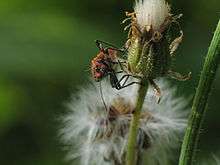Rhopalidae
Rhopalidae, or scentless plant bugs, are a family of true bugs.[1] In older literature, the family is sometimes called "Corizidae". They differ from the related coreids in lacking well-developed scent glands. They are usually light-colored and smaller than the coreids. Some are very similar to the orsilline lygaeids, but can be distinguished by the numerous veins in the membrane of the hemelytra. They live principally on weeds, but a few (including the boxelder bug) are arboreal. All are plant feeders. The type genus for the family is: Rhopalus. Currently 18 genera and over 200 species of rhopalids are known. The oldest fossil rhopalids described are from the Middle Jurassic of Inner Mongolia, discovered from the Haifanggou Formation.[2]
| Rhopalidae | |
|---|---|
 | |
| Rhopalus subrufus | |
| Scientific classification | |
| Kingdom: | |
| Phylum: | |
| Class: | |
| Order: | |
| Suborder: | |
| Infraorder: | |
| Superfamily: | |
| Family: | Rhopalidae |
| Subfamilies | |
| Wikispecies has information related to Rhopalidae |
References
- Henry, Thomas J. (1988). "Family Rhopalidae". In Henry, Thomas J.; Froeschner, Richard C. (eds.). Catalog of the Heteroptera, or True Bugs, of Canada and the Continental United States. Leiden, Netherlands: E. J. Brill. pp. 652–664. ISBN 978-0-916846-44-2.
- Yao, Yunzhi; Wanzhi Cai; Dong Ren (2006). "The first discovery of fossil rhopalids (Heteroptera: Coreoidea) from Middle Jurassic of Inner Mongolia, China". Zootaxa. 1269: 57–68.
External links

| Wikimedia Commons has media related to Rhopalidae. |